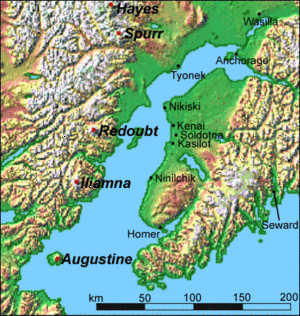|
Volcanoes are mountains which are connected to the molten rock in the center of the earth. There are three types of volcanoes: cinder cone, shield, and composite cone. Each kind of volcano forms in a slightly different way but each one can erupt with amaMt. Spurr Volcanozing force.
Mt Spurr Volcano is located 130 km west of Anchorage and NE of Chakachamna Lake. It is the
highest volcano in the Aleutain arc. Most all of Alaska's volcanoes are located along the 1,500 mile Aleutian Arc that extends westward to Kamchatka and forms the northern part of the Pacific Ring of Fire. Only two eruptions have been recorded at Mt Spurr volcano, in 1953 and 1992.
Mount Spurr, the highest volcano of the Aleutain arc, is a large lava dome constructed at the center of a roughly 5 km-wide horseshoe-shaped caldera that is open to the south. The caldera was formed by a late-Pleistocene or early Holocene debris avalanche and associated pyroclastic flows that destroyed an ancestral Spurr volcano. The debris avalanche traveled more than 25 km to the SE, and the resulting deposit contains blocks as large as 100m in diameter. Several ice-carved post-caldera domes lie in the caldera.
Present Mt. Spurr is the highest of the post-caldera. This regrown summit peak of Spurr experienced a heating event in 2004 which created a small crater lake. By 2008, the summit crater had cooled enough to have begun to have accumulated significant amounts of snow again. The youngest post-caldera dome, Crater Peak (2309m, 7575 ft), formed at the breached southern end of the caldera about 3.2 km south of Spurr, has been the source of about 40 identified Holocene tephra layers.
Spurr's two historical eruptions, from Crater Peak in 1953 and 1992, deposited ash on the city of Anchorage. Crater Peak has a summit crater that is itself slightly breached along the south rim; the north wall of the crater exposes the truncated remains of an older dome or lava lake. Before the 1992 eruption, a small crater lake occupied the bottom of Crater Peak's crater. As with other Alaskan volcanoes, the proximity of Spurr to major trans-Pacific aviation routes means that an eruption of this volcano can significantly disrupt air travel. Volcanic ash can cause jet engines to fail.
Three 1992 eruptions were short-lived and explosive. A moderate explosive eruption began on 27th June and produced an ash which drifted 200 km from the volcano to a height of 9 km. Sulphur dioxide was detected 500 km from the volcano, on satellite images. On 18th August a stronger eruption occurred. Anchorage, 130 km E of Spurr, closed its international airport and most residents stayed indoors. Ash emissions reached a maximum height of 13.5 km. On 21 August, satellite images showed a plume extending 3500 km from central Saskatchewan, to central Alberta, SW British Columbia, and into the Pacific Ocean, off the coast of northern California. A third brief explosive eruption occurred on 16-17 September. Ash fall was reported from communities out as far as Beaver Creek near the Canadian border, almost 600 km away.
On July 26, 2004, the AVO raised the "Color Concern Code" at Spurr from green to yellow due to an increasing number of earthquakes. Earthquakes beneath a volcano may indicate the movement of magma preceding a volcanic eruption, but the earthquakes might also die out without an eruption. In the first week of August 2004, the AVO reported the presence of a collapse pit, filled with water forming a new crater lake, in the ice and snow cover on the summit. This may have been caused by an increase in heat flow through the summit lava dome. On May 3, 2005, a debris flow was observed in webcam images, as well as by a nearby pilot. A subsequent overflight revealed that much of the sitting pond within the melt hole had drained away, a notable depth.
|





